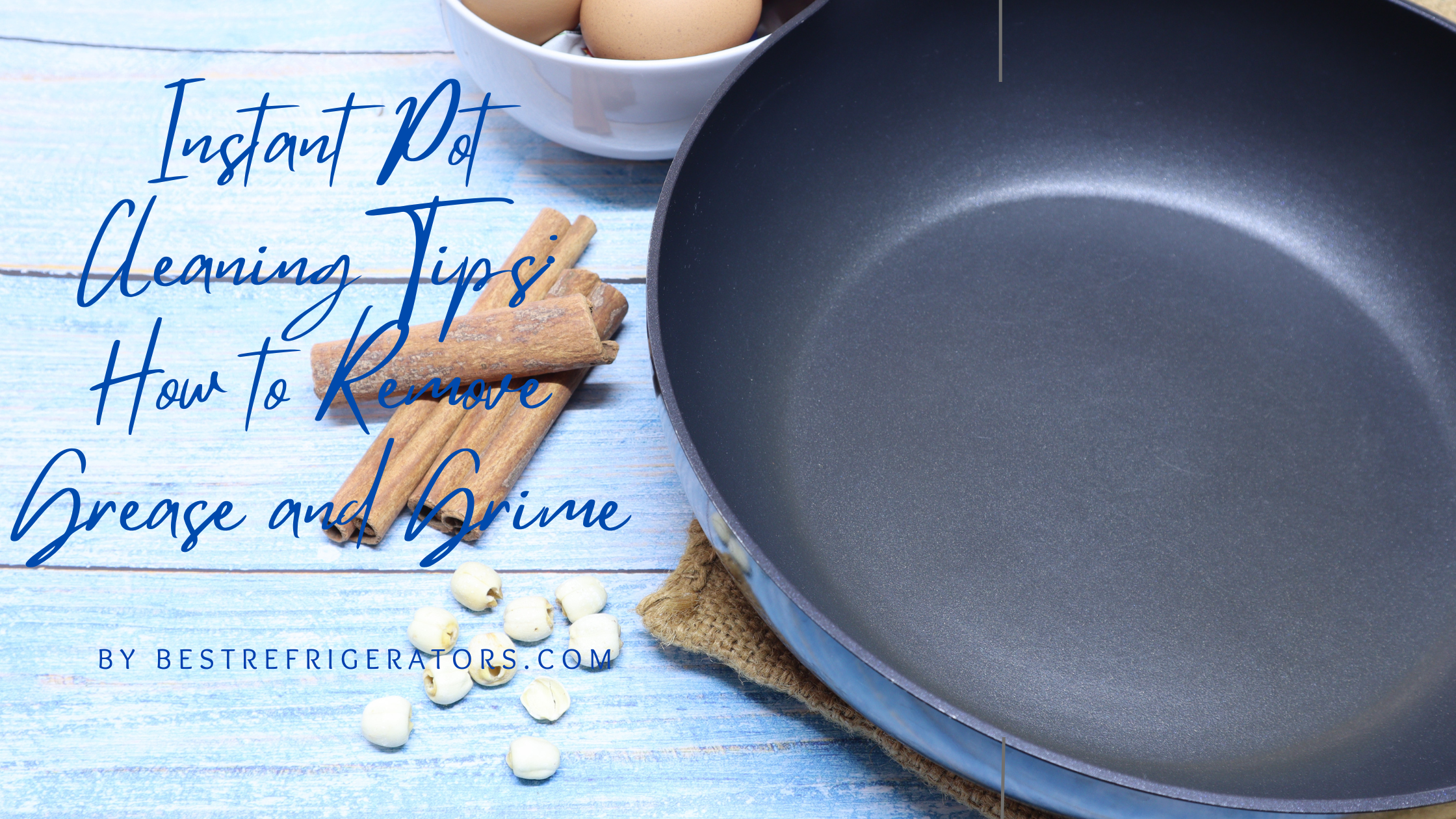
If you own an Instant Pot, then you know that it can be a real lifesaver. But like all other appliances, it needs to be cleaned on a regular basis if you want it to last.
In this blog post, we will discuss how to clean an Instant Pot so that it stays in good condition and continues to work its magic!
Introduction
A. What is an Instant Pot
The Instant Pot is a multi-function pressure cooker that can also be used for sautéing and steam-cooking. It has become wildly popular in recent years since it can reduce cooking times significantly, from hours to mere minutes.
An Instant Pot is multifunctional enough to quickly and easily make a variety of dishes such as chili, stew, soup, egg bites, and even cheesecake. Its combination of different functions gives home cooks the freedom to quickly tailor meals easily while eliminating the need for extra kitchen appliances. Put simply, the Instant Pot makes it easier than ever to cook delicious and healthy family meals without spending all day in the kitchen.
B. Why Cleaning Your Instant Pot Is Important
Cleaning your Instant Pot is essential to its maintenance and will help ensure it continues to operate safely and effectively. The good news is that it's really quite easy and only takes a few simple steps. Cleaning your Instant Pot involves sanitizing the lid, inner pot, seal ring, and steam release handle to make sure no bacteria is growing in any crevices of your appliance.
With simple cleaning techniques such as warm soapy water or running a vinegar cycle through the Instant Pot, you can maintain optimal cleanliness. Regular cleaning can improve the taste of food cooked in the pot and reduce common issues like excessive odor or slow pressure build-up time.
In addition to ensuring safety and improving bland food flavors, staying on top of your Instant Pot’s hygiene will increase its longevity - giving you many years of dinners made with ease.
How to Clean an Instant Pot
A. Disassembling the Parts
1. Lid:
Before cleaning the lid, make sure to turn off your Instant Pot and unplug it from any power source. The lid should be removed first and then rinsed in warm water with a mild soap or detergent, taking care to scrub out any food bits that might have gotten stuck.
It's best to use a soft cloth or sponge to avoid scratching the surface. Once you've finished rinsing and scrubbing, dry with a clean cloth before reassembling it back onto the pot.
2. Inner Pot:
The inner pot should be removed from the appliance and washed with hot soapy water or a vinegar solution (1-part vinegar to 4-parts water). Use a soft cloth to gently scrub any food residue off the walls or bottom of the pot.
Once clean, it should be rinsed thoroughly with cold water and then dried with a clean cloth before being reinserted into the Instant Pot.
3. Sealing Ring:
The sealing ring should also be removed and washed in warm soapy water or a vinegar solution. Again, take care to scrub out any food bits that may have been left behind and then rinse with cold water. Dry the ring before reinserting it into the lid of your Instant Pot.
4. Steam Release Handle:
The steam release handle should also be removed and cleaned in warm soapy water or a vinegar solution.
Use a soft cloth to scrub and remove any food residue that may have built up on the handle, then rinse with cold water and dry before reinserting it back into the lid.
B. Running an Instant Pot Cleaning Cycle
1. Vinegar:
You can also run a cleaning cycle through your Instant Pot using white vinegar. To do this, add 1 cup of white vinegar to the inner pot and fill with 2 cups of water. Close the lid and set the Instant Pot on 'Steam' mode for 5 minutes.
Once finished, allow the pressure to release naturally before opening the lid and discarding the vinegar solution.
2. Soap:
You can also run a cleaning cycle through your Instant Pot using soap and water. To do this, fill the inner pot with 2 cups of warm water and add 1 tablespoon of mild dish soap. Close the lid and set it on 'Steam' mode for 5 minutes.
After the time has elapsed, allow the pressure to release naturally before opening the lid and discarding the soapy water.
3. Rinse:
Once you've finished running a cleaning cycle, it's important to rinse out the pot with cold water to remove any remaining residue or odors from the vinegar or soap solution.
After rinsing, dry with a clean cloth before reassembling the parts and putting your Instant Pot back in use.
C. Regular Maintenance
For best results, it's important to clean your Instant Pot regularly - and not just after each use. Aim to deep-clean your appliance at least once a month to ensure that no bacteria is growing in any crevices or on the inner walls of the pot.
Cleaning techniques such as running a vinegar or soap cycle can help to remove any buildup and keep your Instant Pot in optimal condition.
In addition, make sure to regularly check the sealing ring and steam release handle for any signs of wear or damage. If either piece looks worn or is not functioning correctly, it should be replaced as soon as possible to avoid problems with pressure build-up or steam release. With regular maintenance and cleaning, your Instant Pot should provide you with many years of reliable use.
D. Safety Tips
When cleaning and handling your Instant Pot, it's important to always be aware of safety considerations. Never attempt to disassemble the appliance when it is under pressure or plugged in; always allow any steam to release naturally before removing the lid and unplugging from power sources.
Additionally, take care not to get any water or steam into the electrical components of your Instant Pot, as this could cause a short circuit. Finally, always use caution when cleaning and handling the appliance; never submerge in water or use abrasive cleaners that could damage the surface of your Instant Pot.
Additional Tips for Maintaining Your Instant Pot
A. Avoid Overfilling and Leaks
To keep your Instant Pot functioning properly and avoid potential damage, it's important to never overfill the inner pot or allow any liquids to leak out of the unit.
When cooking, always make sure that all ingredients are below the “Max Fill” line indicated on the inside of the pot. In addition, always check for any signs of leaking around the lid or steam release handle before beginning a cooking cycle.
B. Wipe Down After Every Use
After every use, it's important to wipe down the exterior of your Instant Pot with a damp cloth and mild soap. This will help keep the appliance looking its best and prevent any food residue from building up on its surface.
Additionally, take care to inspect the lid for any signs of damage or wear before reassembling it back onto the pot.
C. Store in a Cool, Dry Place
When not in use, it's important to store your Instant Pot in a cool, dry place away from any direct sunlight. To ensure optimal performance, make sure that the appliance is completely dry before storing and avoid subjecting it to extreme temperatures or high humidity levels.
Additionally, never leave the pot plugged in when not in use; doing so could cause the unit to overheat or even start a fire.
D. Monitor the Seals and Gaskets
The seals and gaskets of an Instant Pot are designed to help keep the appliance airtight and prevent any steam or liquid from leaking out. As such, it's important to regularly inspect them for signs of wear or damage.
If you notice that either piece is worn or no longer functioning correctly, replace it as soon as possible to avoid any potential issues with pressure build-up or steam release.
E. Consult User Manual
Lastly, if you ever have any questions about how to care for your Instant Pot, always make sure to consult the user manual provided with the appliance.
The manual provides detailed instructions on how to clean and maintain your Instant Pot for optimal performance.
Summary
To ensure the longevity and successful operation of your Instant Pot, it's important to regularly clean and maintain the appliance.
This includes wiping down the exterior after each use, inspecting seals and gaskets for signs of wear or damage, cleaning with a vinegar or soap cycle every few months, avoiding overfilling and leakage, storing away from direct sunlight, and consulting the user manual for instructions when needed. With proper care, your Instant Pot should provide you with years of reliable use.
By following these tips and taking good care of your Instant Pot, you’ll be able to keep it functioning for many years to come. So get cooking today–your delicious homemade meals await!












